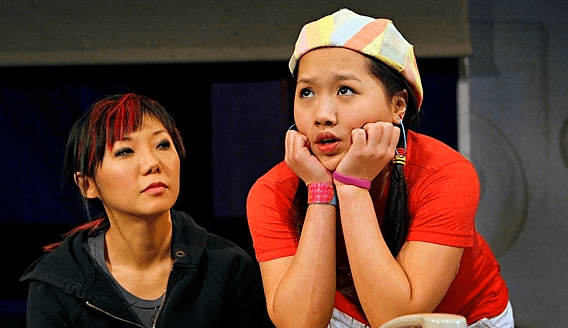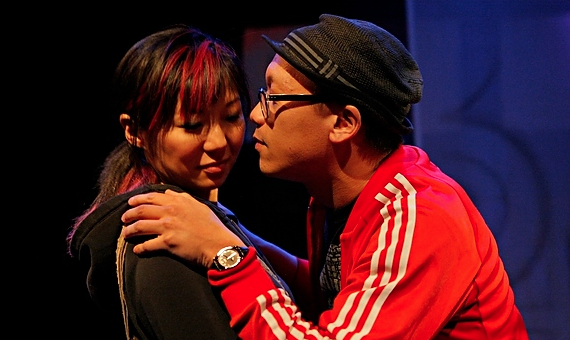
Exploring Hmong culture in the Twin Cities
By Randy Reyes, Community Liaison and Artistic Associate of Mu Performing Arts
I have learned more in the last 2 years about the Hmong culture than I’ve ever had living in the Twin Cities for 6 years. And I don’t know if I ever would have gone on this journey if I wasn’t directing/developing Katie Ka Vang’s play about a Hmong American experience entitled WTF. Maybe it’s because I never bothered asking about this huge immigrant population, or maybe they like to keep to themselves and don’t assertively share their stories. Either way, I feel like I’ve just touched the surface in my insight about this complex and vibrant culture.
My only exposure to the Hmong culture in Minnesota before this project was my friendship with Katie Ka Vang. She was a very outspoken, strong, independent, modern, Hmong woman who exuded style and progressive thought. I knew no other Hmong person and assumed that the culture nurtured these kind of individuals. Looking within our theater, the largest Asian American theater company in the Twin Cities, there had been only a couple of actors and one administrator that I had acquaintances with. All very social and outgoing. Earlier this year I was teaching a workshop at Patrick Henry High School to 2 ELL classes. One class had about 20 students and all of them Hmong except for 1 Nigerian boy. The other class also had about 20 students and they were all Hmong. Mind you, the Hmong students were by no means the majority of the school’s student population. In the beginning of the workshop I asked the students to raise their hands if they immigrated to America more that 10 years ago. I had assumed being in an ELL class, that there would be a number of immigrant students. No one raised their hand. Then I asked them to raise their hand if they had immigrated 5 years ago. No one. 2 years? Nothing. Then the teacher ask them how many were born in America and they all raised their hand. This shocked me. ELL students who were born in America. Who allowed this to happen? The other class was not as extreme but very similar, only two or three were born out of the States. As I got to know the students, they all spoke English well, and some without any accent. What were they doing in this class?
I told this story to my very high functioning Youth Leadership Group at the Center for Hmong Arts and Talent (CHAT) and asked them the same question. This CHAT group is made up of about 10 high school Hmong American students that meet every week to discuss issues and make art. This year they have partnered with Mu Performing Arts to create a play about the issue of polygamy in the Hmong community. I’m leading them in workshops to develop and then direct the play. The youth started to give me insight on these underachieving Hmong students at Patrick Henry. They talked about everything from laziness, to family issues, to wanting a sense of community, to lack of ambition. I talked about the low self esteem that I observed from these Patrick students and the CHAT youth gave me insight on the secrets within the culture that force the youth to stay inward and keep to themselves. So I asked them why they didn’t turn out like that and they explained that they had circles that encouraged them to use their voices and to celebrate themselves and their culture, circles included family, friends, and organizations like CHAT. The Hmong youth needed a voice. I brought this same question about underachieving to my cast of WTF (7 Hmong Americans with 3 former CHAT members) and they explained the importance of family in the Hmong culture, that it was more important that you are a good person to your community and family, than being an ultra successful individual. This is a totally foreign concept to me, a Filipino American madly driven to succeed and fulfill all my dreams with full the focus on self.
There were 2 events that I attended that further intrigued me. The first was CHAT’s art festival where I witnessed an explosion of expression that ranged from dancing (both cultural and break dancing), to singing, to rapping, to textile art, to visual art, to spoken word, to culinary art. And it was exploding! All I saw was a community dying to be heard. And as I looked around I realized that it was mostly their own community listening to them and there was a comfort to that. Do they not want to let others hear? Are others not wanting to hear? The second event was the Hmong New Year at the River Center in St. Paul. There was over 20,000 Hmong at this event, with food, booths, a pagaent, and I could count the non-Hmong in the crowd on both fingers. It was awesome. How could this huge population exist with a community and yet people know so little about them.
These questions energized me as I plunged into WTF rehearsals. I was hungry to learn more. I spent the first week of a 5 week rehearsal process just asking questions and trying to get to the heart of the Hmong American experience. But as more questions were answered, even more questions surfaced. And I realized that just like with every immigrant population in America, their identity continues to change as the journey of celebrating the past and moving to the future pull them to and fro.
The conversations around WTF have been especially fascinating. There is a pressure as a minority artist to write THE quintessential play about the community. I’ve really encouraged Katie to write from her perspective and not worry about representing all Hmong points of view. She doesn’t have to answer all the questions, she just needs to ask the right ones. And from the variety of responses, it seems that she has brought up all the right issues and the community is better for talking about it.
WTF by Katie Ka Vang was performed at the Mixed Blood Theatre by Mu Performing Arts Jan 21-Feb 6, 2011
Recent Content
-
Artsarticle ·
-
Artsarticle ·
-
Artsarticle ·


